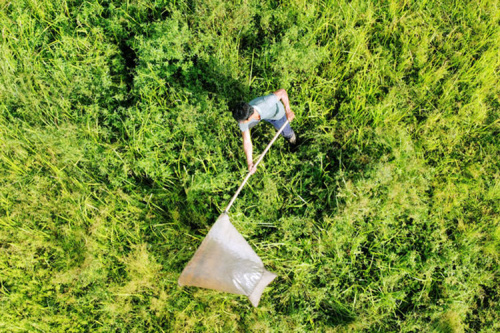Catch a Grasshopper
Catching a grasshopper is fairly easy, as long as you take the appropriate steps to do so. To catch one in its natural habitat, look for an area with tall grass; grasshoppers move slower in the morning or at dusk, so time your search accordingly. You can also make effective traps with molasses or fuzzy blankets to catch a grasshopper.
Contents
Steps
Catching a Grasshopper in its Own Habitat
- Search at peak times. To catch a grasshopper, start your search in the morning or at dusk when it's cooler out- they are slower in the lower temperature than they are in the afternoon heat. Since grasshoppers have the ability to leap across incredible heights and distances, this sort of advantage is very helpful; these creatures can project themselves up to one metre ahead and 25 cm high. Grasshoppers also have the ability to fly, which they often employ when threatened, so trying to catch them when they are operating at a slower pace is an excellent idea.
- Locate grasshoppers. Grasshoppers can be found almost anywhere in the world, save for extremely cold regions like the North and South Pole. Grasshoppers generally live in meadows, fields, or anywhere else they can find food. Look for holes in the tissue and leaves of plants in order to spot where grasshoppers might be feeding. You can also listen for their "singing", or the chirping sound that occurs when they rub their large hind legs against their wings.
- Get a grasshopper into your container. Use a fine mesh net, a container with a lid and air holes, or an old shirt or sheet to catch a grasshopper in an area where you've already identified their presence. Grasshoppers are not difficult to catch; stomp the ground or rustle grass to agitate the grasshoppers and make them "jump" (i.e.catapult themselves off the ground) Once they are moving, position your container, net, or other trap to catch one.
- When grasshoppers feel threatened, they spew a brown liquid as a defense mechanism; the liquid is harmless, but it may stain your clothes.
- Make your container inviting to grasshoppers. If you're trying to catch a grasshopper in a container, fill the container with bits of food that will attract the insect. Put in a slice of apple, some bits of bread, a carrot, or some lettuce. Ideally, use food that is starting to turn, which you would not be consuming anyway.
Setting a Grasshopper Trap
- Set a molasses trap. To catch a grasshopper, try laying out a bucket or small container containing a 10:1 solution of water and molasses. To catch multiple grasshoppers, fill a pond or wading pool with the same solution. Avoid this method if you wish to catch a grasshopper alive; the insect will likely drown in the solution unless retrieved right away.
- Set a glass and soapy water trap. Another option for catching grasshoppers on a larger scale is to set up a pane of glass and a vat of soapy water in a field. Position the pane of glass vertically, with the vat in front of it. The grasshoppers will leap at the pane of glass, fall back into the soapy water, and drown- the soap cuts the surface tension of the water, causing the grasshoppers to sink.
- Set a fuzzy blanket trap. To catch a live grasshopper, to observe or keep as a pet, lay out a fuzzy blanket in a field or other grasshopper-friendly area. To attract grasshoppers to it, spray the blanket with sugar water and sprinkle with breadcrumbs. Leave the trap overnight. Grasshoppers that move across the blanket will get their legs caught in the fuzzy fibers long enough to be picked up or collected in a container.
- To speed things up, agitate the grass around the blanket to drive grasshoppers to leap onto it.
- Set a bottle trap. Cut off the top of an ordinary plastic bottle and reinsert it upside down, so that the opening sits inside the bottle. Tape it together and insert some grass, then leave the trap outside. Grasshoppers will get into the bottle easily by way of the funnel-like top, but they will be unable to get back out.
- Make a yellow trap. Grasshoppers seem to be attracted by the color yellow, so setting a trap that uses this color is worth a shot to catch one. Insects see in the UV spectrum, and light colors reflect more UV light, making them more appealing. Set up a molasses trap in a yellow bucket, or a fuzzy blanket trap with a yellow blanket (or yellow accessories on the blanket) to catch a grasshopper.
Related Articles
- Catch Wildlife to Study
- Make Fried Grasshopper
- Tame a Grasshopper
Sources and Citations
- http://www.espsciencetime.org/student_life.cfm?subpage=326999
- http://a-z-animals.com/animals/grasshopper/
- http://facts.net/grasshopper/
- ↑ https://animalcorner.co.uk/animals/grasshopper/
- https://www.amentsoc.org/insects/fact-files/orders/orthoptera.html#singing
- ↑ http://www.utahfishinginfo.com/tips/catch_bait/grasshoppers.php
- http://billingsgazette.com/news/features/outdoors/out-there-grasshopper-spit-is-yucky-kind-of-defense/article_ef60a901-a43d-5a42-b4a3-f9481ce1b712.html
- http://www.ukpreppersguide.co.uk/eating-insects-for-survival-crickets-and-grasshoppers/
- ↑ https://www.greenharvest.com.au/PestControlOrganic/Information/GrasshopperControl.html
- http://homeguides.sfgate.com/kill-grasshoppers-poison-75854.html
- https://www.ars.usda.gov/news-events/news/research-news/2002/catching-grasshoppers-the-old-fashioned-way/
- http://www.outdoorhub.com/how-to/2014/06/18/catching-summer-baits/
- http://www.backpacker.com/survival/8-edible-bugs-that-could-help-you-survive/#bp=0/img1
- http://www.enature.com/expert/expert_show_question.asp?questionID=9721
